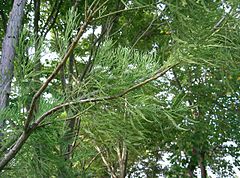Difference between revisions of "Glyptostrobus pensilis"
Jmontilla2 (talk | contribs) |
|||
| Line 20: | Line 20: | ||
|usda_ref=Flora - A Gardener's Encyclopedia ISBN 0881925381 | |usda_ref=Flora - A Gardener's Encyclopedia ISBN 0881925381 | ||
|max_zone=11.5 | |max_zone=11.5 | ||
| − | |image= | + | |image=Glyptostrobus pensilis3.jpg |
|image_width=240 | |image_width=240 | ||
}} | }} | ||
| − | + | '''''Glyptostrobus''''', is a small genus of [[Cupressaceae]] family conifers. The sole living species, ''[[Glyptostrobus pensilis]]'', is native to subtropical southeastern [[China]], from [[Fujian]] west to southeast [[Yunnan]], and also very locally in northern [[Vietnam]]. | |
| + | |||
| + | ''G. pensilis'' is a medium-sized to large [[tree]], reaching {{convert|30|m|ft|abbr=on}} tall and with a trunk diameter of up to {{convert|1|m|ft|abbr=on}}, possibly more. The [[leaf|leaves]] are [[deciduous]], spirally arranged but twisted at the base to lie in two horizontal ranks, {{convert|5|-|20|mm|in|abbr=on}} long and {{convert|1|-|2|mm|in|abbr=on}} broad, but {{convert|2|-|3|mm|in|abbr=on}} long and scale-like on shoots in the upper crown. The [[conifer cone|cones]] are green maturing yellow-brown, [[pear]]-shaped, {{convert|2|-|3|cm|in|abbr=on}} long and {{convert|1|-|1.5|cm|in|abbr=on}} diameter, broadest near the apex. They open when mature to release the small, {{convert|5|-|20|mm|in|abbr=on}} long, winged [[seed]]s. | ||
| + | |||
| + | It typically grows in [[river]] banks, [[pond]]s and [[swamp]]s, growing in water up to {{convert|60|cm|in|abbr=on}} deep. Like the related genus ''[[Taxodium]]'', it produces '[[cypress knee]]s' when growing in water, thought to help transport [[oxygen]] to the [[root]]s. | ||
| + | |||
| + | The species is nearly [[Extinction|extinct]] in the wild due to overcutting for its valuable decay-resistant, scented [[wood]], but it is also fairly widely planted along the banks of [[rice]] [[paddy field|paddies]] where its roots help to stabilise the banks by reducing soil [[erosion]]. | ||
==Cultivation== | ==Cultivation== | ||
| Line 39: | Line 45: | ||
==Gallery== | ==Gallery== | ||
<gallery perrow=5> | <gallery perrow=5> | ||
| − | + | File:Glyptostrobus pensilis2.jpg| photo 1 | |
| − | + | File:Glyptostrobus pensilis1.jpg| photo 2 | |
| − | + | File:Glyptostrobus pensilis 2007.06.28 10.10.35-p6280031.jpg| photo 3 | |
</gallery> | </gallery> | ||
Latest revision as of 12:42, 31 July 2010
| Habit | tree
| |
|---|---|---|
| Height: | ⇕ | 80 ft"ft" can not be assigned to a declared number type with value 80. |
| Width: | ⇔ | 20 ft"ft" can not be assigned to a declared number type with value 20. |
| Lifespan: | ⌛ | perennial |
| Exposure: | ☼ | sun |
|---|---|---|
| USDA Zones: | 8.5 to 11.5 |
|
pensilis > |
Glyptostrobus, is a small genus of Cupressaceae family conifers. The sole living species, Glyptostrobus pensilis, is native to subtropical southeastern China, from Fujian west to southeast Yunnan, and also very locally in northern Vietnam.
G. pensilis is a medium-sized to large tree, reaching 30 m ft tall and with a trunk diameter of up to 1 m ft , possibly more. The leaves are deciduous, spirally arranged but twisted at the base to lie in two horizontal ranks, 5 - 20 mm long and 1 - 2 mm broad, but 2 - 3 mm long and scale-like on shoots in the upper crown. The cones are green maturing yellow-brown, pear-shaped, 2 - 3 cm long and 1 - 1.5 cm diameter, broadest near the apex. They open when mature to release the small, 5 - 20 mm long, winged seeds.
It typically grows in river banks, ponds and swamps, growing in water up to 60 cm in deep. Like the related genus Taxodium, it produces 'cypress knees' when growing in water, thought to help transport oxygen to the roots.
The species is nearly extinct in the wild due to overcutting for its valuable decay-resistant, scented wood, but it is also fairly widely planted along the banks of rice paddies where its roots help to stabilise the banks by reducing soil erosion.
Cultivation
Propagation
Pests and diseases
Varieties
Gallery
References
External links
- w:Glyptostrobus pensilis. Some of the material on this page may be from Wikipedia, under the Creative Commons license.
- Glyptostrobus pensilis QR Code (Size 50, 100, 200, 500)



